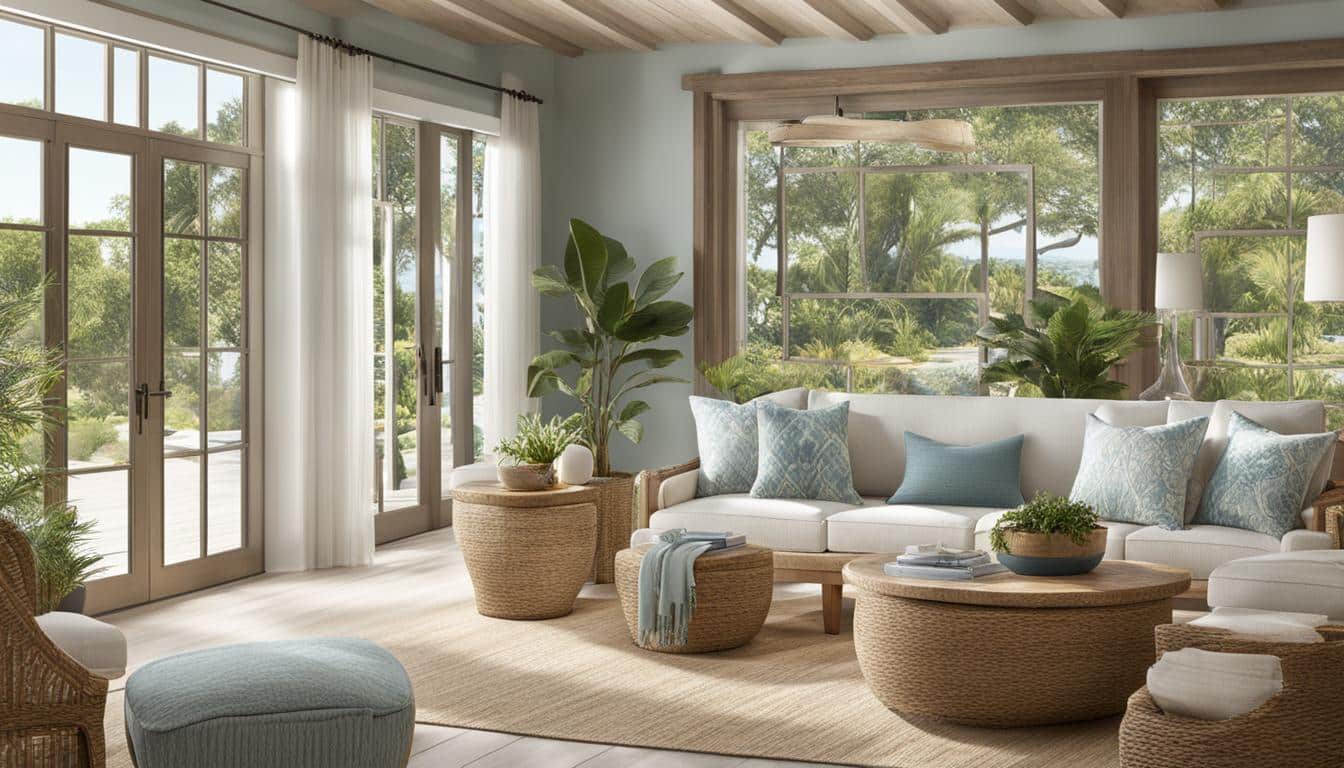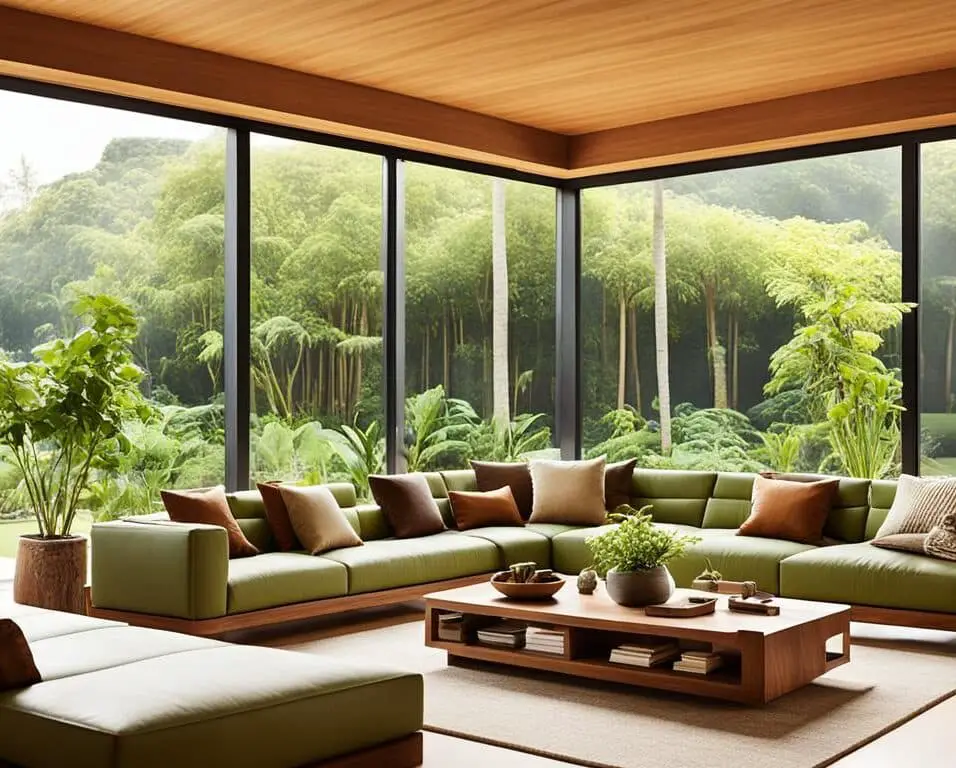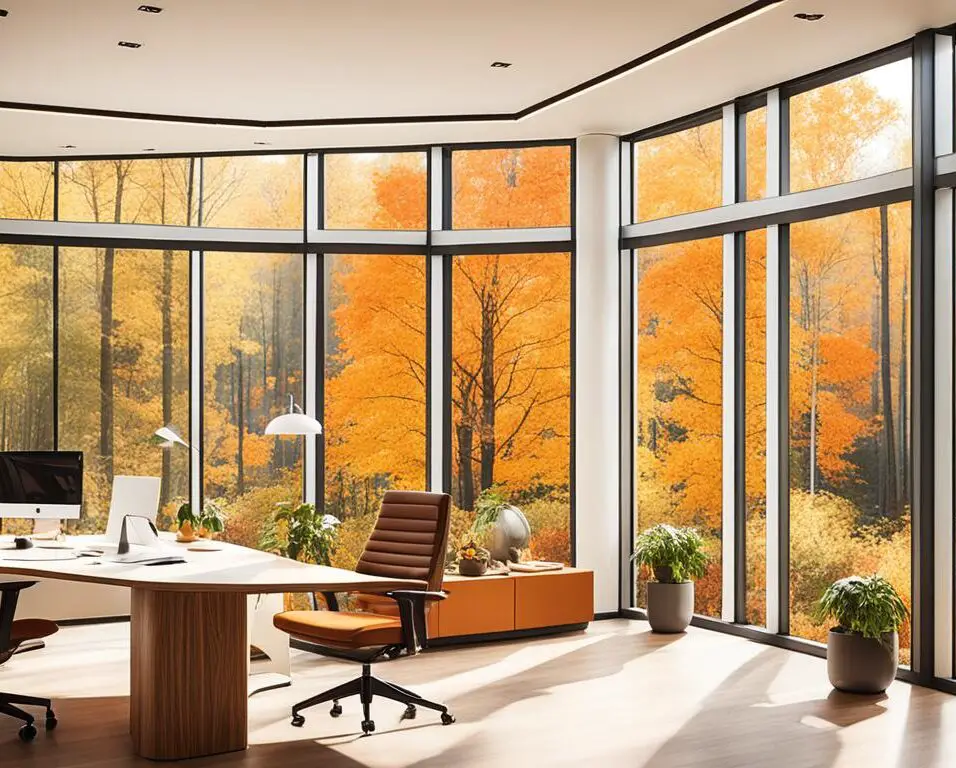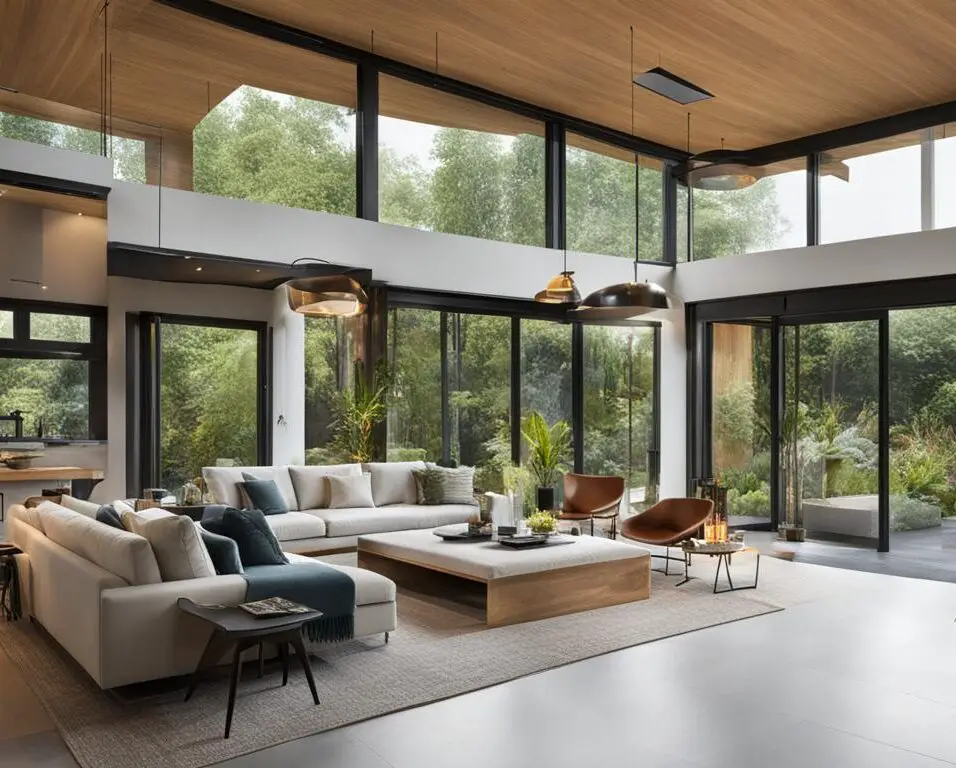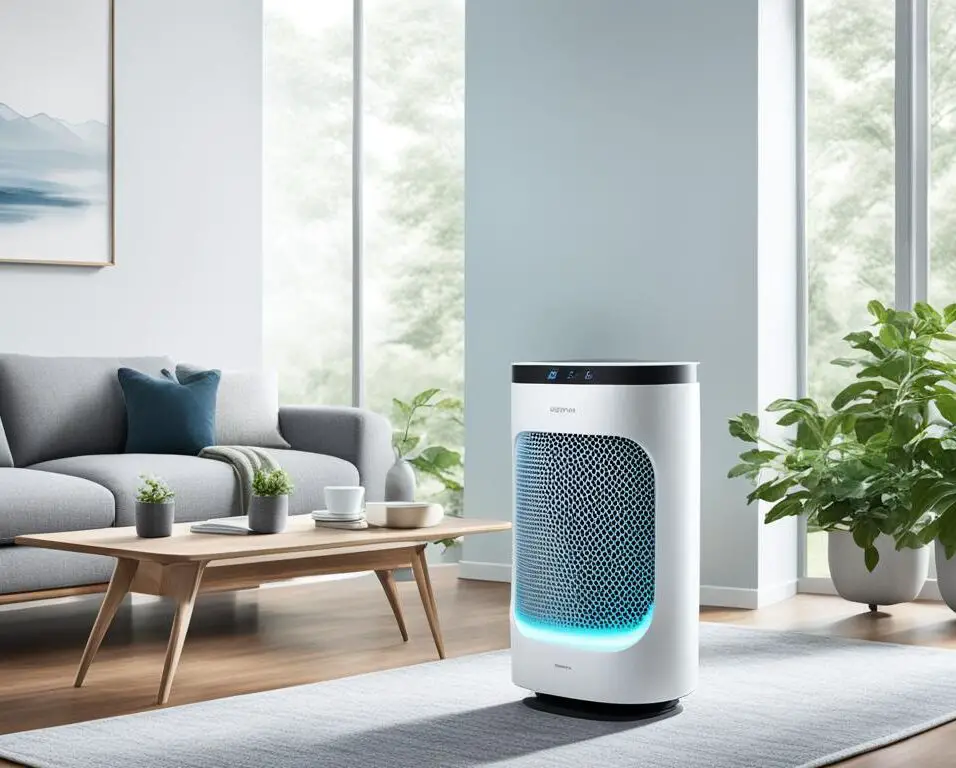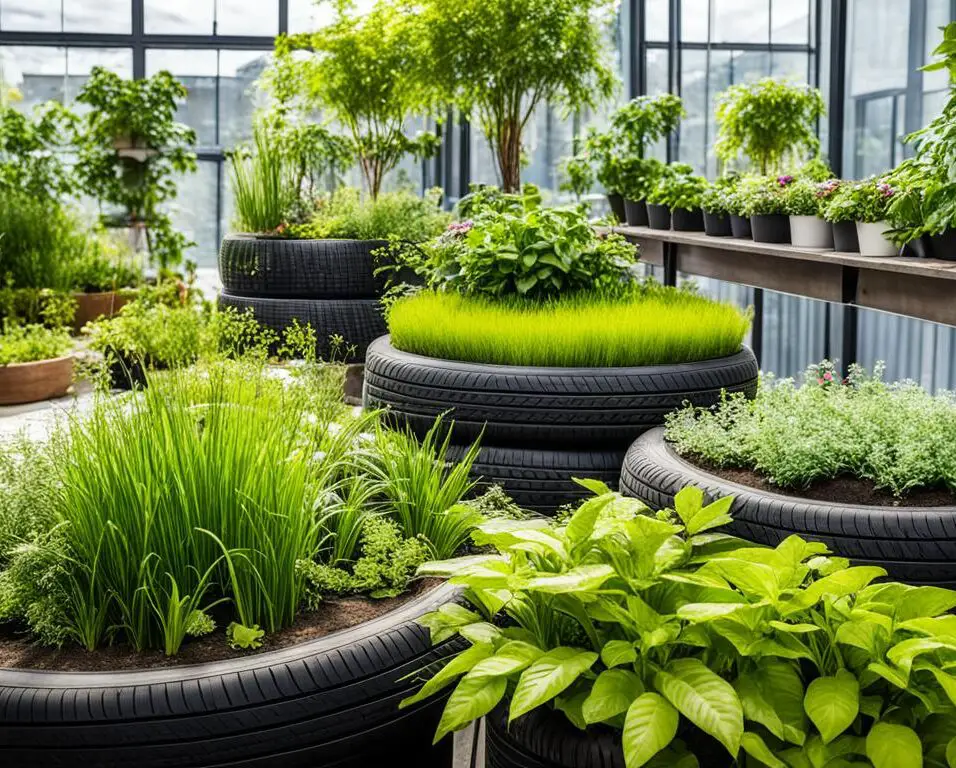Coastal Calm: Biophilic Design in Seaside Homes
Welcome to my article on the serene beauty of biophilic design in coastal homes. As someone who appreciates the seamless integration of nature into the built environment, I am excited to explore the concept of biophilic design and its application in seaside living spaces. In this article, we will delve into the role of biophilic design in enhancing the ambiance of coastal homes and discover creative ideas for incorporating this design philosophy into your own space.
Coastal homes offer a unique opportunity to embrace indoor-outdoor living and connect with the natural splendor of the seaside. By seamlessly blurring the boundaries between indoor and outdoor spaces, these homes create a sense of tranquility and harmony. Through the use of biophilic design principles, we can amplify this connection and embrace the coastal calm within our homes.
Join me as we explore the benefits, ideas, and notable examples of biophilic design in coastal homes. From incorporating natural materials to maximizing natural light and opening up our living spaces, there are countless ways to infuse our homes with the beauty of the seaside.
Key Takeaways:
- Biophilic design seamlessly integrates nature into the built environment.
- In coastal homes, biophilic design enhances the serene ambiance and connection to the seaside.
- Indoor-outdoor living is a concept embraced by coastal homes, blurring the boundaries between inside and outside.
- Biophilic design in coastal homes improves well-being, energy efficiency, and safety.
- Incorporating natural elements, large windows, and open layouts are creative ways to embrace biophilic design in coastal homes.
The Concept of Indoor-Outdoor Living in Coastal Homes
Coastal homes offer a unique opportunity to embrace the concept of indoor-outdoor living. With the beautiful weather and stunning natural surroundings, it only makes sense to blur the boundaries between the inside of the home and the outside. This design approach allows residents to enjoy the comforts of the indoors while feeling connected to nature. Sliding glass doors and open layouts are common design features that seamlessly blend indoor and outdoor spaces in coastal homes.
| Benefits of Indoor-Outdoor Living in Coastal Homes | Enhance the living experience | Create a seamless connection with nature |
|---|---|---|
| 1. Enjoy the best of both worlds | By blurring the lines between indoor and outdoor spaces, residents can have the convenience and comfort of being indoors while still enjoying the beauty and tranquility of their coastal surroundings. | Bringing nature indoors |
| 2. Increased living space | Indoor-outdoor living expands the usable space of a coastal home, providing additional areas for relaxation, entertainment, and enjoying the outdoors. | Expanding living space |
| 3. Natural light and ventilation | By incorporating large windows and open layouts, coastal homes can maximize the amount of natural light and ventilation, creating a bright and airy atmosphere. | Maximizing natural light and ventilation |
| 4. Seamless integration with the coastal landscape | Indoor-outdoor living allows for unobstructed views of the coastal landscape, seamlessly integrating the home with its surroundings and creating a sense of harmony. | Integration with the coastal landscape |
“Indoor-outdoor living is all about creating a harmonious connection between the inside and outside. Coastal homes are perfectly positioned to embrace this concept, allowing residents to fully immerse themselves in the beauty of their natural surroundings.”
Design Tips for Indoor-Outdoor Living in Coastal Homes
- Choose materials that can withstand coastal elements, such as saltwater, sun exposure, and high winds.
- Incorporate outdoor living spaces, such as patios, decks, and landscaped gardens, to encourage outdoor activities.
- Use landscaping to create a sense of privacy while still maintaining a connection to the outdoors.
- Consider the orientation of the home and its relation to the prevailing winds for optimal airflow and ventilation.
- Utilize shading devices, such as pergolas or awnings, to protect outdoor areas from excessive sun exposure.
The Role of Biophilic Design in Coastal Homes
Biophilic design plays a significant role in enhancing the well-being of residents in coastal homes. By incorporating elements inspired by nature, such as natural light, plants, and sustainable materials like bamboo, biophilic design creates a connection to the outdoors even when inside.
“Biophilic design is more than just integrating nature into our built environment. It’s about creating spaces that nourish our senses, evoke emotions, and promote a sense of harmony,” says Jane Adams, an interior designer specializing in coastal homes.
Studies have shown that biophilic design in homes can improve mood, boost creativity, and reduce stress. By bringing elements from the natural world into the interior spaces of coastal homes, residents can experience the calming effects of nature.
Coastal homes can benefit greatly from biophilic design, as it enhances the calming and serene atmosphere that is characteristic of seaside living. Sarah Thompson, a homeowner in a coastal community, shares her experience:
“Incorporating biophilic design into my coastal home has truly transformed the space. The use of natural materials, like reclaimed wood flooring and floor-to-ceiling windows that offer panoramic ocean views, brings the beauty of the coastline indoors. It creates a sense of tranquility that makes my home feel like a retreat.”
By embracing biophilic design principles in coastal homes, residents can cultivate a deeper connection to the coastal environment and experience a greater sense of well-being.
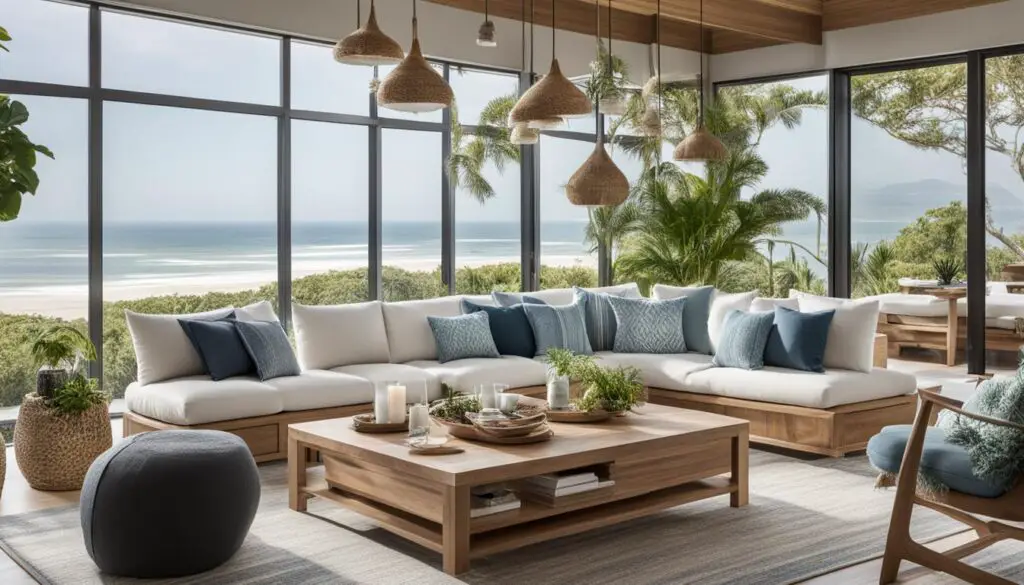
One of the key aspects of biophilic design in coastal homes is the incorporation of natural light. Large windows and skylights can flood the interior with sunlight, making residents feel more connected to the outdoors and creating a bright and airy living space. Additionally, the use of plants not only adds a touch of greenery but also improves indoor air quality and brings the benefits of nature inside the home.
Furthermore, the choice of sustainable materials, such as bamboo or recycled wood, aligns with the eco-conscious mindset that often accompanies coastal living. These materials not only contribute to the overall aesthetics but also promote a sense of environmental responsibility.
The role of biophilic design in coastal homes goes beyond mere aesthetics. It has a profound impact on the well-being of residents, fostering a sense of tranquility and connection to nature. Incorporating biophilic design principles allows coastal homes to truly embrace their natural surroundings and create a harmonious living environment.
Creative Ideas for Incorporating Biophilic Design in Coastal Homes
When designing coastal homes, incorporating biophilic design principles can enhance the connection between residents and the natural beauty of the seaside. Here are some creative ideas to integrate biophilic design elements into coastal homes:
1. Natural Elements
Bringing natural elements into the home creates a sense of calm and connects residents with their surroundings. Utilize materials like bamboo, stone, and wood, which evoke a natural aesthetic. These materials can be incorporated into flooring, furniture, and decor, providing a seamless blend with the coastal environment.
2. Large Windows
Maximize natural light and unobstructed views of the coastal landscape with the use of large windows. These windows act as a frame, allowing residents to fully immerse themselves in the beauty of the seaside from the comfort of their home. The influx of natural light also creates a bright and vibrant living space.
3. Open Layouts
Open layouts facilitate a seamless transition between the indoors and outdoors, enhancing the indoor-outdoor connection. By removing barriers and creating a fluid flow between spaces, residents can enjoy the freedom of movement while feeling connected to the coastal environment. Open layouts also promote better airflow, creating a refreshing and breezy atmosphere.
By incorporating these creative ideas, biophilic design in coastal homes can provide a tranquil and rejuvenating living experience. Connecting with nature through natural elements, large windows, and open layouts creates a harmonious balance between the indoors and outdoors.
| Idea | Benefits |
|---|---|
| Natural Elements |
|
| Large Windows |
|
| Open Layouts |
|
Benefits of Biophilic Design in Coastal Homes
There are several benefits of incorporating biophilic design in coastal homes. Firstly, it enhances the well-being of residents by creating a calming and serene atmosphere. The presence of natural elements and ample natural light can improve mood, increase productivity, and reduce stress. Studies have shown that exposure to nature and natural elements has a positive impact on mental and physical well-being, promoting relaxation and tranquility.
Secondly, biophilic design can contribute to energy efficiency in coastal homes. By maximizing natural light and ventilation, homeowners can reduce their reliance on artificial lighting and air conditioning systems. This not only reduces energy consumption but also lowers utility bills, making it a sustainable and cost-effective design choice.
Lastly, biophilic design can enhance safety in coastal homes, especially for families with young children. Features like cool-to-touch surfaces and automatic shut-off options for lighting and appliances provide added peace of mind. These safety measures, along with careful selection of non-toxic and environmentally friendly materials, ensure a secure and healthy living environment for residents.
Investing in biophilic design in coastal homes not only enhances the connection to nature but also promotes well-being, energy efficiency, and safety. By incorporating elements inspired by the natural surroundings and utilizing sustainable design principles, coastal homeowners can create a harmonious living space that nurtures both the residents and the environment.
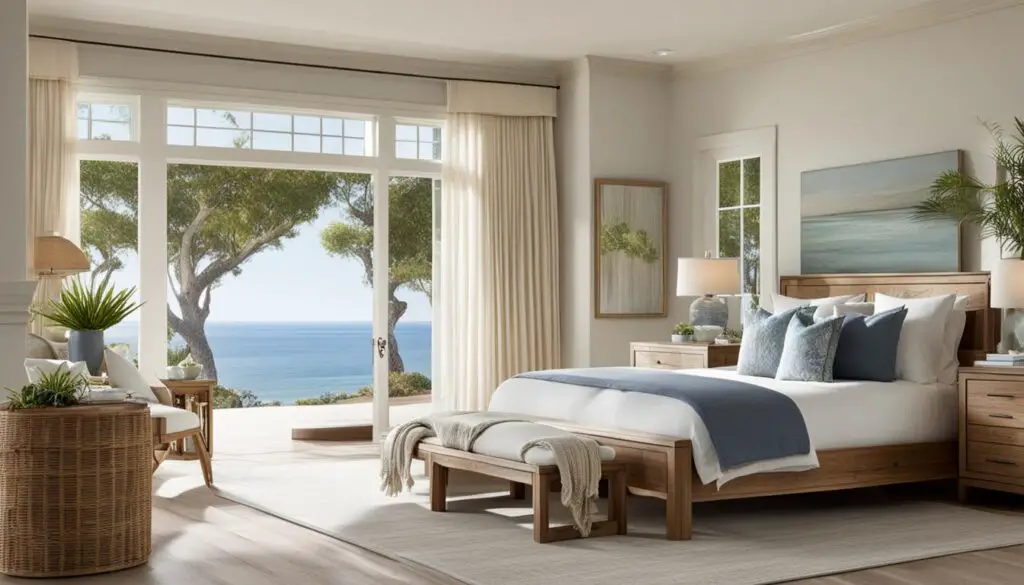
Notable Examples of Biophilic Design in Coastal Homes
Biophilic design in coastal homes offers countless opportunities for incorporating elements inspired by nature. Here, I highlight some notable examples that showcase the seamless integration of biophilic design principles in coastal homes.
Example 1: Living Walls and Sustainable Materials
One striking example of biophilic design in coastal homes is the use of living walls filled with native plants. These vertical gardens not only add a vibrant touch to the indoor space but also improve air quality and create a sense of connection to the natural environment. In addition, incorporating sustainable materials like bamboo flooring enhances the eco-friendliness of the home, aligning with the principles of biophilic design.
Example 2: Maximizing Natural Light and Coastal Views
Coastal homes are known for their breathtaking views, and biophilic design takes full advantage of this asset. Large windows and open layouts are often employed to maximize natural light and provide stunning views of the coastal surroundings. This design approach blurs the boundaries between the indoors and outdoors, allowing residents to feel immersed in nature while enjoying the comforts of their homes.
Example 3: Natural Color Palettes
The use of natural color palettes inspired by the ocean, forests, and beaches is another notable example of biophilic design in coastal homes. Soft shades of blues, greens, and neutrals create a calm and tranquil atmosphere, mimicking the coastal landscape. This color scheme promotes relaxation and fosters a sense of tranquility, making residents feel at peace in their coastal sanctuary.
| Example | Description |
|---|---|
| Living Walls and Sustainable Materials | The use of living walls filled with native plants and incorporation of sustainable materials like bamboo flooring. |
| Maximizing Natural Light and Coastal Views | Integration of large windows and open layouts to maximize natural light and provide stunning views of the coastal surroundings. |
| Natural Color Palettes | Use of natural color palettes inspired by the ocean, forests, and beaches to create a sense of tranquility and connection to the coastal environment. |
Conclusion
In conclusion, biophilic design is a transformative concept when applied to coastal homes. By incorporating natural elements inspired by the seaside environment and maximizing the connection between indoor and outdoor spaces, homeowners can create a living space that truly embodies the serenity and beauty of coastal living. The seamless integration of nature into the built environment not only enhances the overall ambiance but also promotes well-being and energy efficiency.
Through the use of natural materials like bamboo, stone, and wood, coastal homes can embrace the coastal calm and create a sense of tranquility. Large windows and open layouts allow for ample natural light, maximizing views of the breathtaking coastal landscape. This fusion of indoor and outdoor spaces creates a harmonious and rejuvenating environment.
Biophilic design in coastal homes offers a multitude of benefits, including improved mood, increased productivity, reduced stress, energy efficiency, and enhanced safety. By immersing oneself in a home that seamlessly blends with the natural beauty of the seaside, residents can experience a deeper connection with the coastal environment.
Embrace the coastal calm with biophilic design in your coastal home and reap the rewards of living in a space that embodies the tranquility and inspiration of the seaside.
FAQ
What is biophilic design?
Biophilic design is a concept that embraces the seamless integration of nature into the built environment.
How does biophilic design enhance coastal homes?
Biophilic design enhances coastal homes by creating a serene ambiance and connecting residents to the natural beauty of the seaside.
What are some common design features that blur the boundaries between indoor and outdoor spaces in coastal homes?
Sliding glass doors and open layouts are common design features that seamlessly blend indoor and outdoor spaces in coastal homes.
What are the benefits of incorporating biophilic design in coastal homes?
Incorporating biophilic design in coastal homes enhances the well-being of residents, contributes to energy efficiency, and enhances safety.
How can natural elements be incorporated into coastal homes to embrace biophilic design?
Natural elements such as bamboo, stone, and wood can be used as materials in coastal homes to evoke a sense of calm and connect residents with the surrounding nature.
How does biophilic design enhance the well-being of residents in coastal homes?
Biophilic design enhances the well-being of residents in coastal homes by creating a calming and serene atmosphere, improving mood, increasing productivity, and reducing stress.
What are some notable examples of biophilic design in coastal homes?
Examples of biophilic design in coastal homes include living walls filled with native plants, the use of sustainable materials like bamboo flooring, and the integration of large windows and open layouts to maximize natural light and provide stunning views of the coastal surroundings.
Source Links
- https://therealdeal.com/sponsored/bsh/thermador-revolutionizes-induction-technology-with-innovation-and-sustainability/
- https://dtchawaii.com/ideas/creative-ways-to-integrate-indoor-outdoor-living-in-hawaii
- https://www.newsamericasnow.com/latest-caribbean-latin-america-news-7-new-hotels-opening-this-year/



